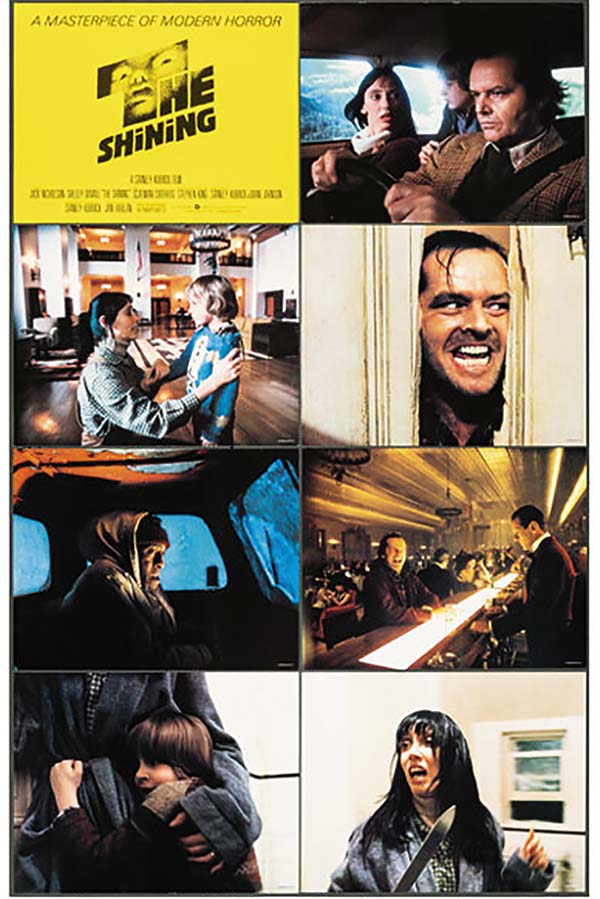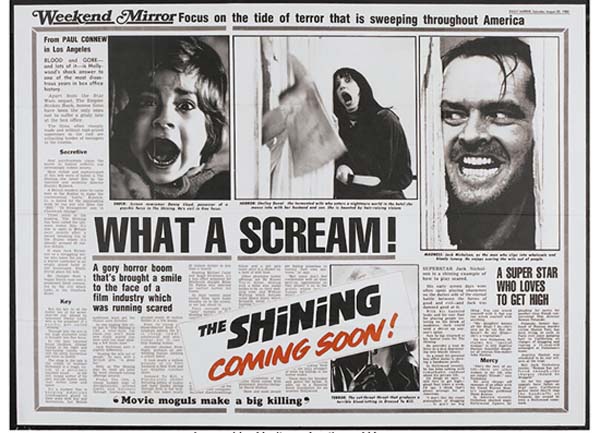Heeeres The Shining! Horror Movie Memories And Memorabilia
By William J. Felchner - September 06, 2024
Stephen King-based movies are legion in Hollywood. It all began with Carrie in 1976, opening the floodgates for a plethora of films inspired by the undisputed master of horror. One of the best Stephen King horror flicks to emerge was 1980s The Shining, King Fears unique take on the old haunted house tale set in the snowy, isolated mountains of Colorado. Stephen King movie fans and collectors have made The Shining one of Kings most famous films, pursuing all manner of memorabilia generated by this all-time horror classic. The Shining, Stephen Kings third published novel and his first hardcover bestseller, was released in 1977 by Doubleday. The novel was inspired by King and his wife, Tabithas, 1974 visit to the old Stanley Hotel in Estes Park, Colo. The Shining was a big commercial success, initially selling 50,000 copies in hardcover and two million copies in paperback. Warner Bros. subsequently purchased the movie rights to The Shining, with director Stanley Kubrick receiving galley proofs of the novel in 1976 prior to publication. Kubrick, who had a personal interest in the supernatural and ESP, wanted to make a horror film that was both commercially successful and artistically satisfying. He apparently found it in The Shining. Budgeted at $19 million, The Shining was written for the screen by Stanley Kubrick and Diane Johnson, with Kubrick also producing and directing. Serving as cinematographer was John Alcott, with Ray Lovejoy as film editor and music by Wendy Carlos and Rachel Elkind. Heading the cast was Jack Nicholson as Jack Torrance, with Shelley Duvall as Wendy Torrance and Danny Lloyd as Danny Doc Torrance. Other cast members included Scatman Crothers as Dick Hallorann, Barry Nelson as Stuart Ullman, Philip Stone as Delbert Grady, Joe Turkel as Lloyd the bartender, Anne Jackson as Doctor, Tony Burton as Larry Durkin, Lia Beldam as young woman in bathtub, Billie Gibson as old woman in bathtub, Barry Dennen as Bill Watson and Lisa and Louise Burns as the Grady girls. Production on The Shining began in May 1978. Most of the filming took place at EMI Elstree Studios, located in southern England, where multiple sets were constructed depicting the fictional Overlook Hotel. One of the largest sets constructed was a spectacular, life-size replica of the hotels exterior. Second unit production crews filmed the movies exterior scenes back in the United States, most notably in Montana and Oregon. By July 1979, filming was completed at all locations, and The Shining was in the can. The Shining opens with a majestic aerial view of Jack Torrance in his Volkswagen Beetle heading to a job interview at the remote Overlook Hotel in Colorado. Jack, a schoolteacher and aspiring writer, is applying for the job of caretaker at the hotel, which closes its doors every winter due to adverse weather conditions and impassable roads. Here he meets the hotels manager, Stuart Ullman, who informs Jack of his duties, which primarily involve keeping the boilers going in order to prevent any winter damage to the old hotel. Its not a difficult job, Ullman says, but the isolation could be a problem. Ullman then reluctantly relates the story of a previous caretaker named Charles Grady who, a decade earlier, had apparently succumbed to an extreme version of cabin fever, murdering his wife and two young daughters. An undeterred Jack, who is looking for a little isolation as he is working on a new writing project, takes the job as caretaker, where he is later joined by wife Wendy and young son Danny. While on a final tour of the hotel led by head chef Dick Hallorann, who is headed to Florida for the winter, Danny exhibits the shining, a telepathic ability which he shares with Dick. The chef then tells Danny that the Overlook possesses a shine also, where residue from past events lurk in the hotel. This is especially true for Room 237, a place where Dick warns Danny to avoid. The Torrances settle in to their new digs, but things begin to slowly unravel. Jack, a recovering alcoholic now suffering from writers block as well, becomes increasingly moody and agitated, snapping at his wife and son. The hotels past residue eventually surfaces, as Jack encounters the Overlooks ghostly apparitions. Jack is now taking refuge in the Gold Room, a throwback to the Roaring Twenties, where he is drinking once again thanks to the hospitality of the ghostly bartender Lloyd. Encouraged by the apparition of Delbert Grady to correct the wayward Wendy and Danny, Jack eventually snaps and goes on a rampage. Jack later corners his family in a bathroom, breaking down the door with an axe and sticking his head through the ragged opening, maniacally announcing a la Ed McMahons famous The Tonight Show opening for host Johnny Carson, Heeeres Johnny! Dick Hallorann, telepathically summoned by Danny from Florida, reaches the hotel via snowcat in a raging blizzard. Still armed with the axe, Jack ambushes the chef in the hotel lobby, leaving him for dead and continuing his pursuit of Wendy and Danny outside in the snow-covered hedge maze. The Shining ends with a vintage group photograph of the Overlook Hotel dated July 4, 1921. Pictured among the revelers is a grinning Jack Torrance, who apparently had always been the hotels designated caretaker. The Shining was released in the United States on May 23, 1980, initially opening in ten selected movie theaters in Los Angeles and New York City. The movie subsequently made its UK debut on Oct. 2, 1980, featuring a shorter version in which director/producer Kubrick had axed 25 minutes of multiple scenes taking place outside the Overlook Hotel. Reviews for The Shining were a mixed bag. Janet Maslin of The New York Times praised Nicholsons performance as the deranged, haunted Jack Torrance and the Overlook Hotel for its spooky setting, but opined that the actual story made little sense. Gary Arnold of The Washington Post panned the movie, calling the picture the Big Letdown of the new film season, adding, I cant recall a more elaborately ineffective scare movie. The biggest critic of all was Stephen King himself, citing the old writers lament that The Shining was a poor adaptation of his novel. The Shining would later be remade into a three-part TV miniseries, which ran on ABC from April 27 to May 1, 1997, starring Steve Weber, Rebecca De Mornay, Courtland Mead and Melvin Van Peebles. This version of The Shining, written by Stephen King and filmed at the Stanley Hotel in Estes Park, was Kings answer to Stanley Kubricks 1980 movie, which King had found so disappointing. King himself makes a cameo in the TV miniseries, gleefully playing Gage Creed, the conductor of a Big Band orchestra performing in the Gold Room. The Shining, which grossed $47.3 million during its initial release, eventually overcame many of the negative reviews from 1980 to become one of the true classic films in the horror genre. The Shining generated a myriad of equally classic movie memorabilia, with the films standard one sheet poster leading the way. A great deal of time and effort went into selecting The Shinings basic poster design. Stanley Kubrick and celebrated Hollywood graphic designer Saul Bass looked at over 300 potential variations before settling on an angry, frightened, bug-eyed face staring through the word The with the Shining below it and the blurb at top, A Masterpiece of Modern Horror. Bass wanted the poster to be black on a red background, while Kubrick preferred black on a yellow background, with Kubricks color scheme eventually winning the day. A standard one sheet poster (27-by-41 inches) of The Shining in rolled very fine+ condition sold at auction for $360. High on any collectors want list is the films deluxe lobby card set, which was originally displayed in movie theater lobbies. Numbering 13 color cards (11-by-14 inches) and depicting various memorable scenes from the production, one set in very fine/near mint condition brought a top bid of $312 at auction. Also available is the films mini lobby card set, comprised of nine 8-by-10-inch color scene cards. One example in very fine- condition realized a top bid of $48 at auction. One of the rarer The Shining movie posters is Saul Basss own limited edition silk screen print (20-by-27 inches), which he had printed at Krebs Studio and subsequently distributed as gifts to the Museum of Modern Art, various exhibitions and friends from around the world. This was the black on red poster that Bass had originally wanted for the film but had been rejected by Stanley Kubrick in favor of the yellow background version. Numbering only 150 copies, one example of this poster, with its accompanying official identification card, in rolled fine/very fine condition, sold at auction for $9,000. Foreign The Shining movie posters are also available. The British so-called What A Scream! advance film poster (30-by-40 inches) is, well, a real scream, featuring a grinning Jack Nicholson, a terrified Shelley Duvall, et al, in all their horrific glory. One example in folded very fine+ condition brought a top bid of $49 at auction. Another superb foreign movie poster is the Japanese B2 movie poster (20-by-28 inches) picturing Jack Nicholson and Shelley Duvall. One example in rolled very fine+ condition sold at auction for $50. The Australian Daybill poster (13-by-27 inches), with the blaring tagline, The tide of terror that swept America Is Here, is also of prime interest to collectors. One example in folded very fine/near mint condition brought $51 at auction. Privately commissioned poster prints have gained in popularity in recent years. The Shining has witnessed its fair share, with one 2021 limited-edition print (36-by-24 inches) by Karl Fitzgerald featuring Jack Nicholson as the budding writer Jack Torrance at his Adler manual typewriter (All work and no play makes Jack a dull boy) comprises one of the more attractive pieces. One example, hand-numbered 32 of 35 and in rolled near mint condition, realized $1,080 at auction. Original movie props are always very big with collectors. One of the most iconic pieces from The Shining, of course, is the axe wielded by movie maniac Jack Hereees Johnny Nicholson. There were, in fact, several stunt axes made for various uses in The Shining. One was a lightweight version, measuring 35 inches, made of rigid polyfoam and expertly crafted/painted to resemble the real thing, which Jack Nicholson could then tote around with relative ease. This particular prop, showing some wear and damage from movie use, sold at auction for $27,500. Auction results and images are courtesy of Heritage Auctions, Dallas, Texas. William J. Felchner is a graduate of Illinois State University. His work has appeared in a number of periodicals, including True West, Hot Rod, Movie Collectors World, Big Reel, Old West, Corvette Quarterly, Goldmine, Autograph Collector, Illinois, Sports Collectors Digest, Frontier Times and Pennsylvania Magazine.












SHARE
PRINT